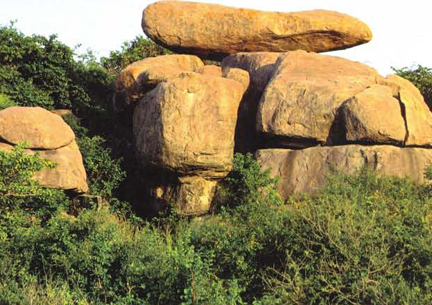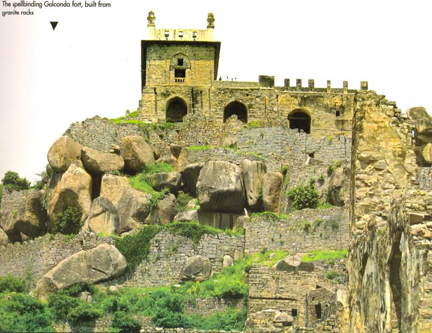The unique rock formations of Hyderabad
-Geeta Verghese
Hyderabad has changed so much in the past two decades that it bears no resemblance to the laid back city of the eighties, when even the rickshaw drivers with their polite and courteous manners bore the stamp of a bygone era of the Nizams. Sometime in the
early nineties, a friend had mentioned to me that a German lady Frauke Quader had started a Society to ‘Save the Rocks’, which were facing the onslaught from the construction boom. It was then that I began noticing these unique rock formations, which attract
one’s attention as the train approaches Hyderabad. Huge boulders, the tip of one balancing on the tip of another, part of nature’s ballet formed to the beat of centuries of thunderstorms.
So when I recently found myself spending a weekend in Hyderabad, I contacted the society in the hope that I could be a part of one of their walks. Thanks to Ms Quader’s efforts we were able to arrange a trip with a doctor couple from Mumbai who were in the
city for a conference and our guides for the afternoon were Dr Hina Gokhale and her husband, scientists from DRDO. They had chosen a spot on the outskirts of Hyderabad near the Delhi Public School. All around were the new high-rise buildings, which have become
the footprints for an ever-expanding metropolis.

The Gokhales took us by a winding route to a spot where we could spot a rock formation, which comprised of a rocky hillock with huge boulders stacked one above the other like a club sandwich. We began our climb asking passersby the direction to the dargah.
Finally we reached the 400 year-old dargah of a sufi saint who had come from Iran. As was customary, there was a family, which by tradition tended to the place, preserving its ambience. From this place we were able to spot our destination, the cluster of rocks,
which could serve as a vantage point to survey the surroundings.
The next two hours just sped by when we began scrambling over those rocks. We edged our bodies through tunnels formed by the boulders, looking up at slivers of sunlight that came through the gaps, with cries of “Wow, just look at that.” Sometimes those tunnels
came to intersections where, taken up with the atmosphere of the place, the silence and the beam of sunlight illuminating the spot we felt tempted to sit there cross-legged in a Buddha pose. Whenever we came out into the open we could survey the scene around
us. Hina pointed out adjacent rock formations that had been reduced to rubble by building contractors, which looked bald and pathetic. Climbing down we found ourselves suddenly in an enclosure surrounded by those mighty rocks. There was a small temple with
a lingam and some carvings, which looked ancient. There was something about this whole place, which gave it a spiritual feel. A little further we came across a cave formed by the boulders. A board proclaimed that a Jain Baba had resided there for some weeks
a few decades before.
At this point, exhausted but exhilarated we took a break and while having some oranges, Hina told us that the rock formations on the Deccan Plateau were unique in the world. These were formed when molten rock spewed out of the earth’s innards in prehistoric
times and that was the reason for such unusual forms, almost as if droplets had frozen and were then shaped into such a variety of forms by subsequent erosion. She also pointed out that our flora and fauna could through proper conservation measures be brought
back from the brink of extinction but these rock formations once gone are gone forever. The society had managed to have about 26 rock formations declared as heritage sites, which would be preserved but the rocks which had given us such pleasure that afternoon
were not part of these and were probably already on death’s row waiting to be reduced to rubble to end up as granite for another high-rise building. The sun was setting as we traced our way back to the parking lot, hoping that the presence of the dargah and
the temple would be the lifeline that could save this rock formation from extinction.

Photos Anita Satyajit from the website
http://www.saverocks.org